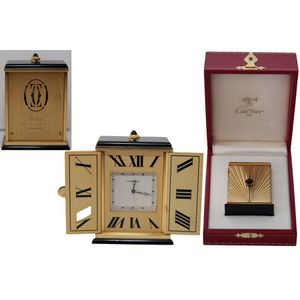Breche D'Alep Marble Top Tulipwood Commode
You must be a subscriber, and be logged in to view price and dealer details.
Subscribe Now to view actual auction price for this item
When you subscribe, you have the option of setting the currency in which to display prices to $Au, $US, $NZ or Stg.
- Cabriole Leg - The cabriole leg evolved from an elongated scroll, curving out at the knee which may or may not be carved, and forming a serpentine shape as it descends to the foot.
First introduced into English furniture in the late 17th century, cabriole legs were widely used during the Queen Anne and early Georgian periods, where they frequently terminated in a pad foot or ball and claw foot. The style has had many imitators since then. The cabriole leg was re-introduced in the mid-19th century, and is commonly associated with the balloon-back dining or drawing-room chairs made in walnut, mahogany or, in Australia, cedar. The Victorian cabriole leg, on the whole, was rather more slender than the earlier form, following the French style, which emphasized the delicacy and daintiness of the chairs they were designed to support. Cabriole legs are sometimes found on windsor chairs, especially those made during the 18th century. - Bronze - An alloy of copper and tin, traditionally in the proportions of about 9 parts of copper to 1 part of tin.
The discovery of bronze in Western Asia in the 4th century enabled people to create metal objects which were superior to those previoulsy possible because of its strength and hardness, and it has been used throughout the world for weapons, coins, tools, statuary and other decorative items.
It is very fluid in a molten state, and its hardness, strength when set, and non-corrosive properties makes it most suitable for casting sculpture. - Parquetry - Parquetry is inlay laid in geometric patterns, the contrast being achieved by the opposing angles of the grain and veneers. The herringbone pattern is the most commonly used in flooring, but this is almost never seen in furniture - the patterns used are more complex and unlike flooring, can include several different varieties of timber.
- Circa - A Latin term meaning 'about', often used in the antique trade to give an approximate date for the piece, usually considered to be five years on either side of the circa year. Thus, circa 1900 means the piece was made about 1900, probably between 1895 and 1905. The expression is sometimes abbreviated to c.1900.
- Breakfront - A design generally found in larger pieces of furniture, such as bookcases, wardrobes and some sideboards. The line of the front is interrupted by the middle section standing out from each end. In a reverse breakfront, the centre section is recessed behind each end. Breakfronted pieces are usually made in three sections the middle and the two wings which are held together by the cornice and pediment, and the plinth on which it stands. The sensible buyer should show caution before buying breakfront pieces, especially bookcases, which are highly desirable and expensive. Always check that the timber, colour, patination, backboards, decoration and thickness of the wood are same in each section.
- Commode - The word "commode" when used to describe an item of furniture, has three usuages:
1. As used to describe an item of English furniture, it refers to what is euphemistically called a 'night table', that is a small cabinet concealing a chamber pot.
2. In its 18th century French usuage it describes a low and highly decorated chest of drawers for salons and reception rooms. A bombe commode is a commode with rounded sides and front, giving the chest a somewhat swollen look.
3. It is also used to denote a half round or serpentine shaped cabinet, with panelled doors, standing on legs. They were pieces on which the cabinetmaker lavished his most accomplished art, with rich veneers, marquetry inlays, gilt mounts and other ornamentation.
This item has been included into following indexes:
Visually similar items

A Must de Cartier travel clock, quartz, mounted in onyx and gold plate, signed reference 8915 02706, boxed and with papers

An Austrian four ducat gold coin pendant, 18ct yellow gold mounted, set with a 24ct yellow gold Austrian 4 Ducat gold coin, claw set within a pierced, scalloped frame of 18ct yellow gold, set with bail. Coin weight: 13.96grams

9ct gold, amethyst and opal necklace, approx 7.57 grams,

Assorted miniature portraits, hand painted on ivory, paper and porcelain, framed (13)
